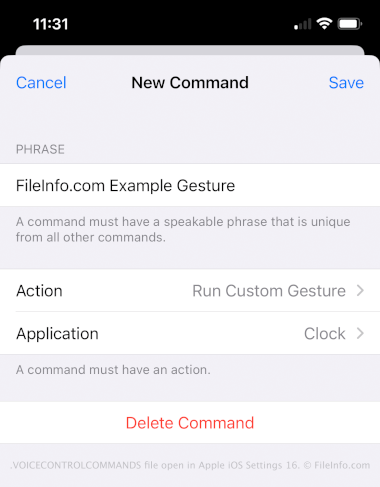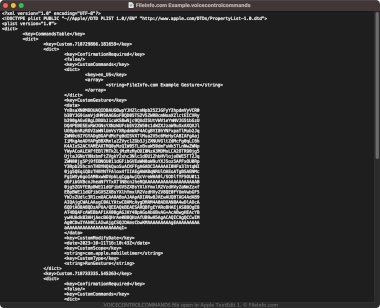.VOICECONTROLCOMMANDS File Extension
iOS Voice Control Commands File
| Developer | Apple |
| Popularity |
1.3 | 3 Votes |
What is a VOICECONTROLCOMMANDS file?
A VOICECONTROLCOMMANDS file contains one or more commands an iOS device runs when a user speaks them through the device's Voice Control Settings feature. Users export and import VOICECONTROLCOMMANDS files via Voice Control (in the iOS device's Accessibility settings) to share custom commands between iPhone, iPad, and iPod touch devices. Since the file stores commands and their metadata in the XML standard, users can also open, view, and modify the information with a text editor.
More Information
Apple provides various vision, hearing, and physical and motor features to make its iOS devices more accessible. These features are helpful for people with disabilities and those looking to customize how they control specific aspects of their device (i.e., creating shortcuts to save time).
One of the accessibility features is Voice Control, which enables you to create custom commands the device runs when you speak to it. For example, you can speak commands to perform gestures, dictate and edit text, and interact with screen elements.
How to access Voice Control commands in iOS
To access the Voice Control capabilities on your iOS device, tap Settings → Accessibility → Voice Control. Then, to create a voice control command, select Customize Commands → Custom → Create New Command. After making your command(s), you can export it (them) to a VOICECONTROLCOMMANDS file by selecting Export Custom Commands from the "Customize Commands" screen.
How to open a VOICECONTROLCOMMANDS file
You can open a VOICECONTROLCOMMANDS file via the Voice Control feature in an iOS device's Accessibility settings. To open a VOICECONTROLCOMMANDS file, tap Settings → Accessibility → Voice Control → Customize Commands → Import Custom Commands.
Apple Xcode and Fat Cat PlistEdit Pro also support VOICECONTROLCOMMANDS files if you transfer them from your iOS device to a Mac.
Opening a VOICECONTROLCOMMANDS file with a text editor
Since VOICECONTROLCOMMANDS files are saved in plain text, you can also open them with a text editor, such as Microsoft Notepad (Windows) or Apple TextEdit (Mac). You may need to rename the file extension to .txt for the text editor to recognize it.
When opened, you can modify the properties of the file. Remember that if you incorrectly edit the file, you may inadvertently break the commands.

